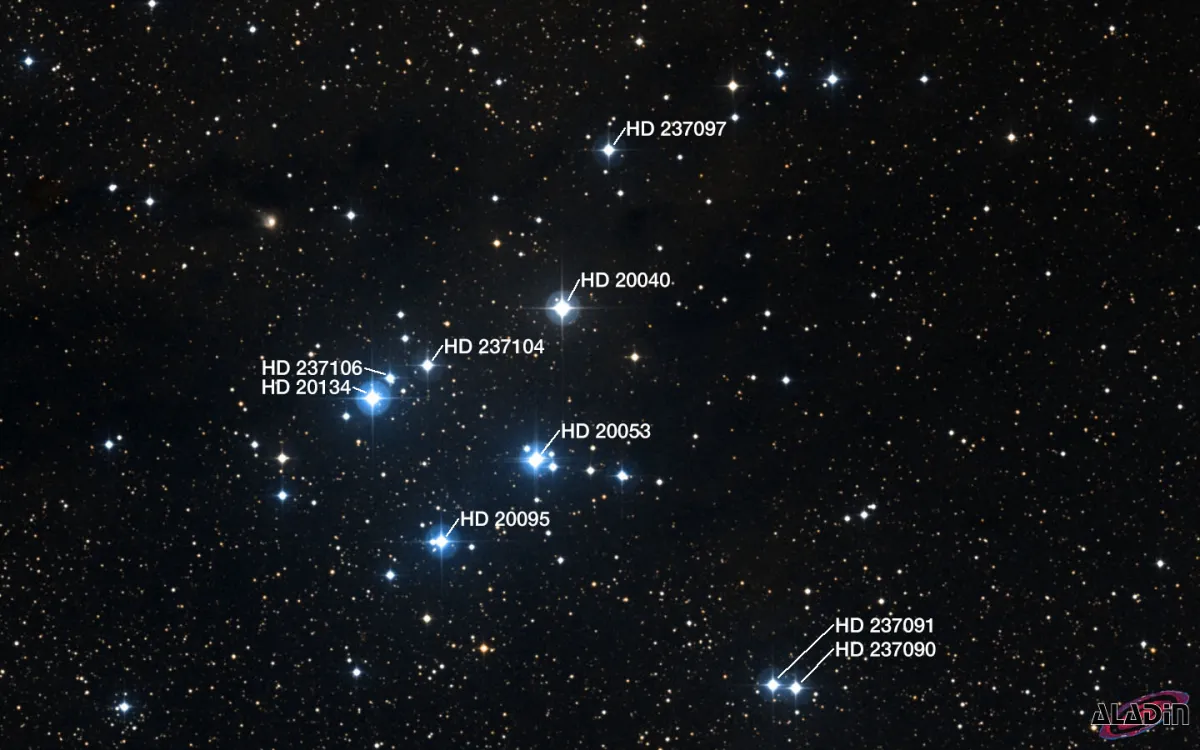Pazmino's Cluster (Stock 23)

History
This star cluster was discovered in the second half of the 1950s by the German astronomer Jürgen Stock and first appeared in the first edition of the «Catalogue of Star Clusters and Associations» in 1958. [570] Jürgen Stock was later responsible for selecting the sites of the observatories on Cerro Tololo and La Silla in Chile. [571]
Sometimes you will also find the term «Pazmino's Cluster», which goes back to an article by John Pazmino in the March 1978 issue of «Sky & Telescope».
Physical Properties
Some sources refer to Stock 23 as an asterism and not a true cluster, as the brighter stars have different parallaxes and proper motions (see table 1). However, a study of the 3D morphology using Gaia EDR3 data revealed that Stock 23 is an open cluster with a filamentary structure. The distance is given as 606.7 pc and the cluster of 78 stars with about 106 solar masses is moving towards us at -18.57 km/s. The age of the cluster is estimated to be -18.57 km/s. The age of the cluster is estimated to be -18.57 km/s. The age of the cluster is estimated at 94 million years. [573] Most scientific sources referenced in Simbad refer to an open cluster. Simbad gives an extent of 90 arcminutes for Stock 23, with the centre about 15 arcminutes north of the conspicuous V-shaped asterism. [145]
The one 9 mag star (HD 237090), which is conspicuously further away at 1136 parsecs, has a high radial velocity of 128.8 km/s away from us. Presumably it was ejected from the cluster due to gravitational interaction.
| Name | RA [hms] | Dec [dms] | vMag | spType | PM RA [mas/y] | PM Dec [mas/y] | RV [km/s] | PLX [mas] | Dist [pc] |
|---|---|---|---|---|---|---|---|---|---|
| HD 20040 | 03 16 10.818 | +60 06 57.41 | 7.54 | G2III | -13.398 | -1.686 | -34.5 | 2.5105 | 398 |
| HD 20053 | 03 16 17.370 | +60 02 7.10 | OB- | -28 | |||||
| HD 20095 | 03 16 41.919 | +59 59 26.70 | 8.12 | A0V | 17.640 | -17.383 | 1 | 4.1324 | 242 |
| HD 20134 | 03 16 59.751 | +60 04 2.97 | 7.47 | B2.5IV-V | -4.377 | -1.021 | -12.50 | 1.6648 | 601 |
| HD 237090 | 03 15 10.928 | +59 54 42.80 | 9.03 | B0.5IV:nn | 1.263 | -0.807 | 128.80 | 0.8799 | 1136 |
| HD 237091 | 03 15 16.751 | +59 54 49.18 | 9.3 | B1:V:nnep | -0.200 | -2.857 | 7.60 | 5.1230 | |
| HD 237097 | 03 15 58.799 | +60 12 1.71 | 9.03 | F6IV | 53.002 | -101.384 | -5.40 | 7.1175 | 140 |
| HD 237104 | 03 16 45.559 | +60 05 6.76 | 9.05 | F6IV | -25.629 | 9.943 | -14 | 6.3699 | 157 |
| HD 237106 | 03 16 55.226 | +60 04 41.92 | 9.81 | A0 | -4.137 | 1.939 | 1.973 | 507 |
The cluster is embedded in a faint H-II region (Sh 2-202, LBN 676), crossed by some dark clouds (LDN 1383, 1385). About three degrees west is the well-known Soul Nebula (IC 1848), which together with Heart Nebula (IC 1805) is a popular target for astrophotographers.
| Name | Stock 23 |
| Object Type | Open Cluster |
| Right Ascension (J2000.0) | 03h 16m 03s |
| Declination (J2000.0) | +60° 19' 52" |
| Parallaxes | 1.613 mas |
| Radial velocity | -21.453 km/s |
| Redshift z | -0.000072 |
| Angular size | 90.5' × 90.5' |
| Identifiers | C 0312+598; Cl Stock 23; OCl 375.0; [KPR2004b] 41; [KPS2012] MWSC 0266 |
Finder Chart
Stock 23 is located in the constellation Camelopardalis, close to the two fourth magnitude stars CE and CS Camelopardalis. The IAU boundary line to the constellation Cassiopeia runs right through the middle of this cluster. On 14 November it is in opposition to the Sun and culminates at local midnight. The best observation time is from July to April, when the constellation, which is circumpolar in Central Europe, is highest in the sky.
